
National 5 Maths
Trigonometric Graphs
Course content
-
Working with the graphs of trigonometric functions:
- basic graphs
- amplitude
- vertical translation
- multiple angle
- phase angle
Textbook page references
- Zeta National 5+ Maths
 pp.208-214
pp.208-214 - TeeJay Maths Book N5 pp.156-169
- Leckie National 5 Maths pp.249-271
N5 Maths revision course
National5.com self-study courseSave £10 with discount code 'Maths.scot'
Basic trig graphs

- Period = 360° (width of one wave)
- Amplitude = 1 (half the height)
- Roots: 0°, 180°, 360°
- Maximum turning point (90,1)
- Minimum turning point (270,–1)

- Period = 360°
- Amplitude = 1
- Roots: 90°, 270°
- Maximum t.p. (0,1) and (360,1)
- Minimum turning point (180,–1)
- It's the sine graph moved left 90°

- Period = 180°
- Amplitude is undefined
- Roots: 0°, 180°, 360°
- No maximums or minimums
- "Asymptotes" at \(x\) = 90° and 270°
Change of amplitude
Now we will use the sine function to look at change of amplitude and the other three transformation types that you need to understand for Nat 5 Maths.
Example: \(y=5\small \ \normalsize sin\ x\)
- Amplitude 5 (vertical stretch: \(\times\)5)
- Maximum turning point (90,5)
- Minimum turning point (270,–5)
Example: \(y=\small \frac{1}{2}\tiny \ \normalsize\normalsize sin\ x \)
- Amplitude \( \small \frac{1}{2}\) (vertical shrink: ÷2)
- Maximum turning point (90,\( \small \frac{1}{2}) \)
- Minimum turning point (270,\( –\small \frac{1}{2} \))
Example: \(y=-sin\ x\)
- Amplitude remains 1
- Reflects in the \(x\)-axis (upside-down)
- Maximum turning point (270,1)
- Minimum turning point (90,–1)
Example: \(y=-3\small \ \normalsize sin\ x \)
- Amplitude 3 (vertical stretch: \(\times\)3)
- The graph also reflects in the \(x\)-axis
- Maximum turning point (270,3)
- Minimum turning point (90,–3)
Vertical translation
Example: \( y=sin\ x+2 \)
- The basic graph moves up 2
- Maximum turning point (90,3)
- Minimum turning point (270,1)
Example: \( y=sin\ x-1 \)
- The basic graph moves down 1
- Maximum turning point (90,0)
- Minimum turning point (270,–2)
Vertical transformations
Now let's combine a change of amplitude and a vertical translation.
Example: \(y=2\small \ \normalsize sin\ x+3\)
- First, the amplitude doubles
- Then that graph moves up 3
- Maximum turning point (90,5)
- Minimum turning point (270,1)
Example: \(y=\small \frac{1}{2}\tiny \ \normalsize \normalsize sin\ x-1\)
- First, the amplitude halves
- Then that graph moves down 1
- Maximum turning point (90,\( \small -\frac{1}{2} \normalsize \))
- Minimum turning point (270,\( \small -\frac{3}{2} \normalsize \))
Example: \(y=-2\small \ \normalsize sin\ x+5\)
- Amplitude \( \times \)2 (double-height)
- Reflect in the \(x\)-axis (upside-down)
- Then move the graph up 5
- Maximum turning point (270,7)
- Minimum turning point (90,3)
Multiple angle
Example: \(y=sin\ 2x\)
- Each \(x\)-value divides by 2
- Horizontal shrink: half-width
- The period is 360 ÷ 2 = 180°
- There are 2 cycles from 0° to 360°
- Roots 0°, 90°, 180°, ...
Example: \(y=sin\ \small \frac{1}{3}\normalsize x\)
- Each \(x\)-value divides by \(\small \frac{1}{3}\), i.e. \(\times\)3
- Horizontal stretch: triple-width
- The period is 360 ÷ \(\small \frac{1}{3}\) = 1080°
- There is \(\small \frac{1}{3}\) of a cycle from 0° to 360°
- Roots 0°, 540°, 1080°, ...
Example: \(y=sin\ (-4x)\)
- Each \(x\)-value divides by –4
- Horizontal shrink: quarter-width
- Also a reflection in the y-axis
- The period is 360 ÷ 4 = 90°
- There are 4 cycles from 0° to 360°
- Roots 0°, 45°, 90°, 135°, ...
- The SQA has never set a question with a negative multiple angle.
Phase angle
Example: \(y=sin\ (x-60)°\)
- Horizontal translation: right 60°
- Roots 60°, 240°, 420°, ...
Example: \(y=sin\ (x+45)°\)
- Horizontal translation: left 45°
- Roots –45°, 135°, 315°, ...
A useful way to remember:
- MINUS and RIGHT: 5 letters each
- PLUS and LEFT: 4 letters each
Horizontal transformations
Now let's combine a multiple angle and a phase angle. An unexpected thing happens: the phase angle always acts before the multiple angle. PM, not MP!
Example: \(y=sin\ (2x+60)° \)
- First, we translate left 60°
- Then each \(x\)-value divides by 2
- The period is 360 ÷ 2 = 180°
- Roots: 60°, 150°, 240°, 330°, ...
Example: \(y=sin\ (\small \frac{1}{2}\normalsize x-30)° \)
- First, we translate right 30°
- Then each \(x\)-value divides by \( \frac{1}{2} \)
- The period is 360 ÷ \( \frac{1}{2} \) = 720°
- Roots: 60°, 420°, 780°, ...
2D transformations
Finally, we need to be able to combine horizontal and vertical transformations.
Example: \(y=3\small \ \normalsize sin\ (x+25)° \)
-
Horizontal:
- Translate left 25
- No multiple angle here
- The period remains 360°
-
Vertical:
- Stretch: amplitude becomes 3
- No reflection or translation
- Max. turning point (65,3)
- Min. turning point (245,–3)
Example: \(y=-2\small \ \normalsize sin\ 3x - 4 \)
-
Horizontal:
- No phase angle here
- All \(x\)-values divide by 3
- The period is 120°
-
Vertical:
- Stretch: amplitude becomes 2
- Reflect in the \(x\)-axis
- Then translate down 4
- Max. value: –2\(\times\)–1 – 4 = –2
- Max. turning point (90,–2)
- Min. value: –2\(\times\)1 – 4 = –6
- Min. turning point (30,–6)
Example: \(y=5\small \ \normalsize sin\ (2x-30)°+1 \)
-
Horizontal:
- Translate right 30°
- Then \(x\)-values divide by 2
- The period is 180°
-
Vertical:
- Stretch: amplitude becomes 5
- Then translate up 1
- Max. value: 5\(\times\)1 + 1 = 6
- Max. turning point (60,6)
- Min. value: 5\(\times\)–1 + 1 = –4
- Min. turning point (150,–4)
So far, the SQA have only included two or three of the four transformation types in their questions, so that last example should have over-prepared you!
All past paper questions so far have involved a given graph, from which you need to identify either the equation or the coordinates of a turning point. Some past paper questions are explained below.
Example 1 (non-calculator)
SQA National 5 Maths 2015 P1 Q6
Part of the graph of \(y=a\,sin\,bx^\circ\) is shown in the diagram.
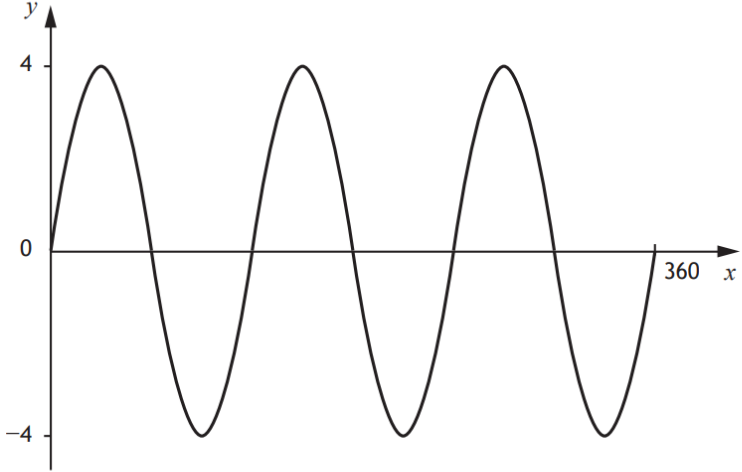
State the values of \(a\) and \(b\small.\)
Example 2 (non-calculator)
SQA National 5 Maths 2018 P1 Q6
Part of the graph of \(y=a\,cos\,bx^\circ\) is shown in the diagram.
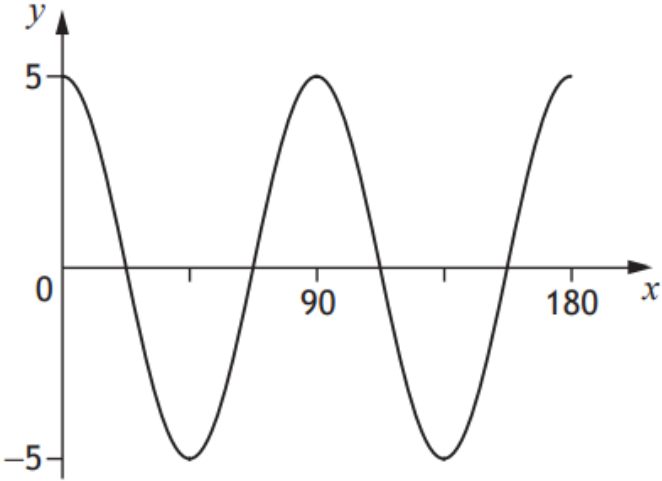
State the values of \(a\) and \(b\small.\)
Recommended student book
Zeta Maths: National 5 Maths TextbookExample 3 (non-calculator)
SQA National 5 Maths 2019 P1 Q13
Part of the graph of \(y=3\,cos(x+45)^\circ\) is shown in the diagram.
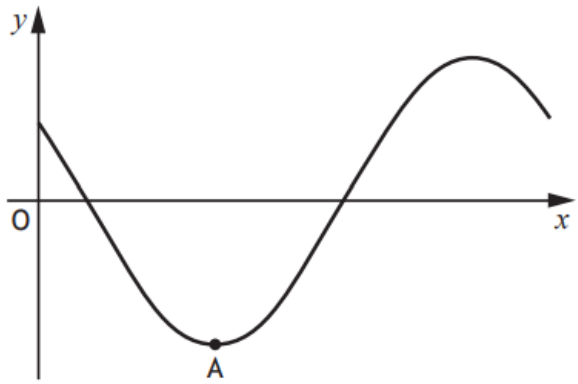
The graph has a minimum turning point at A. State the coordinates of A.
Example 4 (non-calculator)
SQA National 5 Maths 2021 P1 Q13
The graph of \(y=a\,cos\,x^\circ +b\small,\) \(0\leq x\leq 360\small,\) is given.
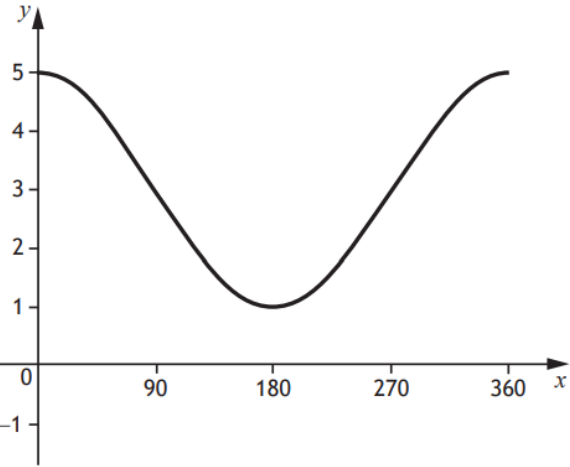
State the values of \(a\) and \(b\small.\)
N5 Maths practice papers
Non-calculator papers and solutionsCalculator papers and solutions
Example 5 (non-calculator)
SQA National 5 Maths 2022 P1 Q8
Part of the graph of \(y=a\,sin\,bx^\circ\) is shown in the diagram.
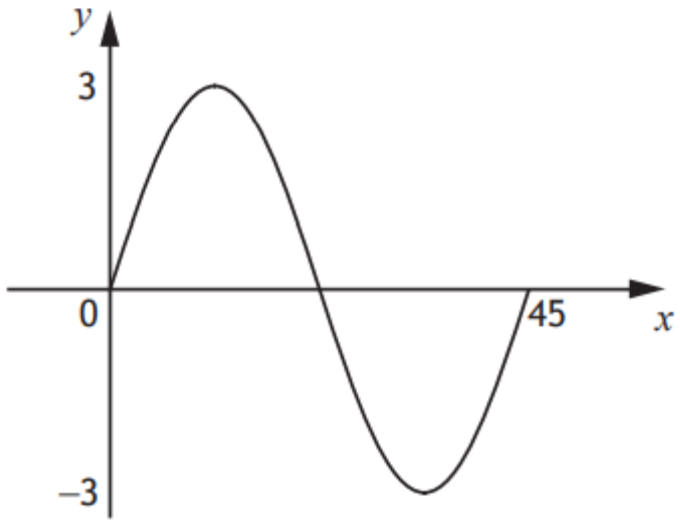
(a) State the value of \(a\small.\)
(b) State the value of \(b\small.\)
Example 6 (non-calculator)
SQA National 5 Maths 2023 P1 Q13
Part of the graph of \(y=cos(x+a)^\circ + b\) is shown.
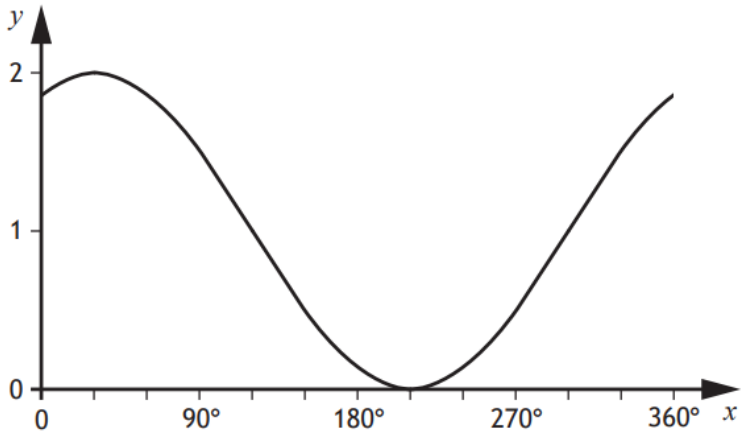
(a) State the value of \(a\small.\)
(b) State the value of \(b\small.\)
Need a Nat 5 Maths tutor?
Just use this handy little widget and our partner Bark.com will help you find one.
Past paper questions
Other great resources
| Videos - Mr Graham Maths 1. Amplitude 2. Period 3. Vertical translation 4. Phase angle |
| Videos - Mr Hamilton Online 1. Amplitude and period 2. Vertical shift 3. Horizontal shift 4. Summary: sin and cos 5. Trig graph exam questions |
| Video - YouKenMaths |
| Video - Tutorlene |
| Notes and videos - Mistercorzi |
| Notes and examples - Mearns Maths |
| PowerPoint - MathsRevision.com |
| Interactive graphing tool - NCTM |
| • Detailed notes - BBC Bitesize • Test yourself - BBC Bitesize |
| Notes - Maths4Scotland |
| Notes - National5.com |
| Notes - D R Turnbull |
| Lesson notes - Maths 777 1. Basic, amplitude and period 2. Translations in either direction |
| Examples - Maths Mutt 1. Sketching trig graphs 2. Amplitude and period |
| Practice questions - Maths Hunter |
| Worksheets - Starting Points Maths 1. Maximum and minimum values 2. Horizontal transformations 3. Complete workbook |
| Exercises - Larkhall Academy Pages 22-29 Ex 1-3 |

Click here to study the trig graphs notes on National5.com.
You may also want to check out their Nat 5 Maths self-study course. We think it's excellent. If you decide to enrol, just use coupon code "Maths.scot" to get £10 discount.
|
⇦ Nat 5 topic list ⇧ Top of this page
|
